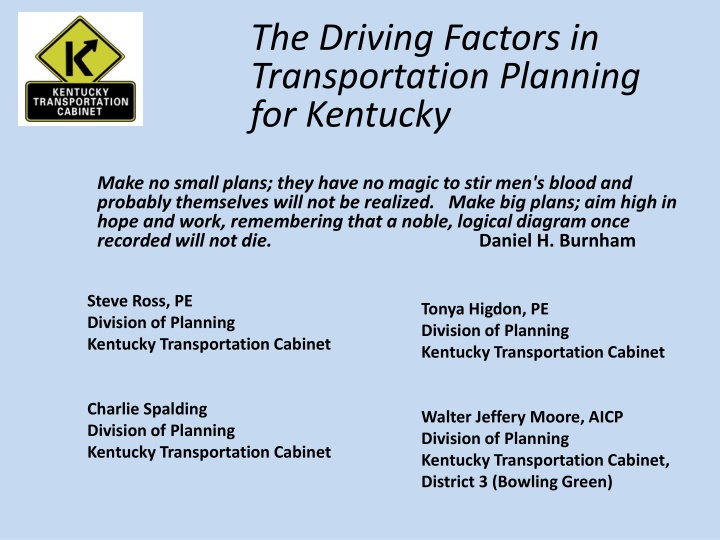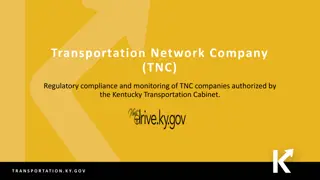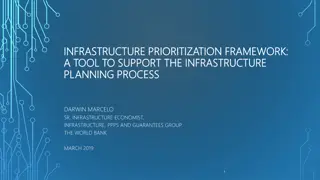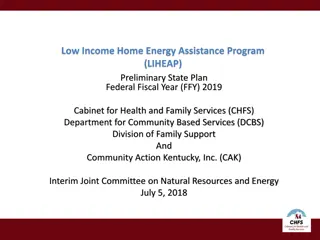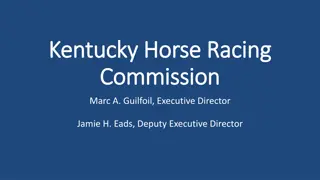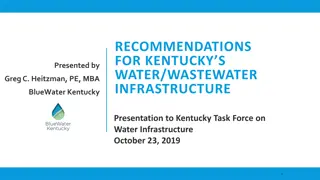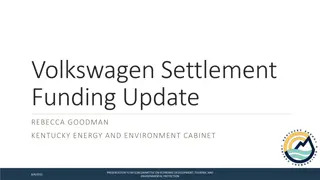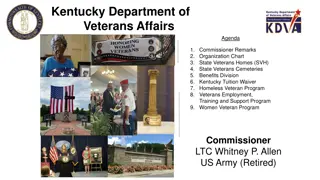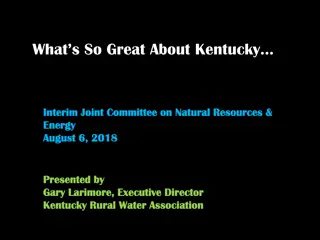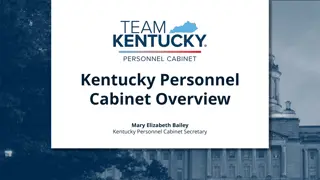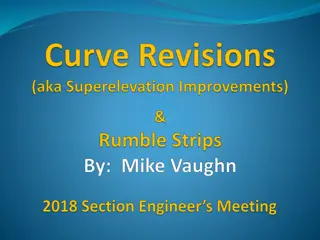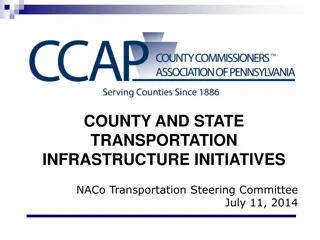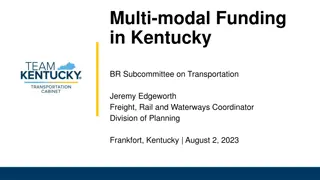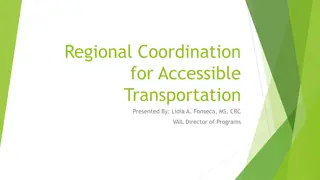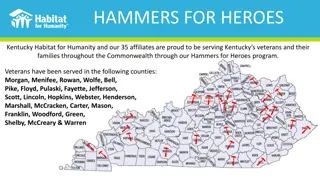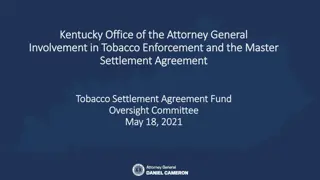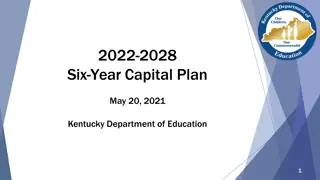Comprehensive Transportation Planning Framework for Kentucky's Infrastructure Development
Kentucky's state transportation planning involves creating big, ambitious strategies to enhance infrastructure, comply with federal regulations, and engage in dialogue with the community. The process incorporates factors such as traffic volumes, roadway data, accidents, development needs, and cultural/environmental considerations. Communication with various stakeholders, including the public and officials, plays a critical role in shaping the vision and operational planning for the state's transportation system.
Download Presentation

Please find below an Image/Link to download the presentation.
The content on the website is provided AS IS for your information and personal use only. It may not be sold, licensed, or shared on other websites without obtaining consent from the author.If you encounter any issues during the download, it is possible that the publisher has removed the file from their server.
You are allowed to download the files provided on this website for personal or commercial use, subject to the condition that they are used lawfully. All files are the property of their respective owners.
The content on the website is provided AS IS for your information and personal use only. It may not be sold, licensed, or shared on other websites without obtaining consent from the author.
E N D
Presentation Transcript
The Driving Factors in Transportation Planning for Kentucky Make no small plans; they have no magic to stir men's blood and probably themselves will not be realized. Make big plans; aim high in hope and work, remembering that a noble, logical diagram once recorded will not die. Daniel H. Burnham Steve Ross, PE Division of Planning Kentucky Transportation Cabinet Tonya Higdon, PE Division of Planning Kentucky Transportation Cabinet Charlie Spalding Division of Planning Kentucky Transportation Cabinet Walter Jeffery Moore, AICP Division of Planning Kentucky Transportation Cabinet, District 3 (Bowling Green)
Federal Regulations for State Long-Range Transportation Planning Each State shall carry out a continuing, cooperative, and comprehensive statewide multimodal transportation planning process, Each State shall develop a statewide transportation plan (LRP) and a statewide transportation improvement program (STIP) for all areas of the State. The statewide transportation plan (LRP) and the transportation improvement program (STIP) provide for the development and integrated management and operation of transportation system that considers all modes of transportation. will serve the mobility needs of people and freight. fosters economic growth and development within and between States and urbanized areas. minimizes transportation-related fuel consumption and air pollution.
Planners: We are the Keepers of the Stuff Current/Future Traffic Volumes & Classification Existing Roadway Information Form (Highway Information System) Function (Systems) Accidents: Type Location Frequency Commercial-Industrial Development Needs Intermodal Connections (Ped, Bike, Transit, Freight) Cultural and Environmental Resources Project Info: 6 Year Plan, District Transportation Plan, and Specific Area/Corridor Planning Studies
Communication The most important element of the planning process is the conversation held with the members of the community. Who are they? Joe & Jane Public Local & State Officials Area Development Districts Metropolitan Planning Organizations Other KYTC Divisions Stakeholders (including other agencies) What do we talk about?
Vision Operations Planning Process Process Construction Design Process The Transportation World is Round!
Components of a Successful Planning Process Engineering Input Local Official s Input Public Input
PLANNING STUDIES: "Broad Brush Planning" Planning Studies Small Urban Area Corridor MPO Long Range Plans Road Safety Audits (Highway Safety Improvement Program) State Long Range Transportation Plan Identification of Transportation Needs Development of Needs into Projects
Project Identification Form (PIF) Gather & Review Data Describe the Project, its Origin, & Purpose Existing Conditions Form: Geometrics Function: Traffic (Count & Type) Function: Crashes Opportunities & Challenges Utilities, Right of Way Environmental Issues Economic Issues
Visualize a Funnel Needs Solutions
Transportation Needs Funnel Knowledge Driven: Technical, Public & Political Input Inactive Projects Active Unscheduled Needs (UNL) Necessary? No High Priorities (Base List)* Needs! Project ID Form (PIF) Is it an Immediate need? Yes District Transportation Plan Process (DTP) Top 30 Projects Unscheduled Projects Prioritization Planning Design KYTC Recommended Six Year Highway Plan Right of Way DNA: Data Needs Analysis Utilities Construction Approved Six Year Highway Plan *Note: These high priority projects of the Base List are determined from the Consultation Process, both externally & internally. The identification of these Base List projects takes into consideration historical rankings & current demand conditions. Maintained Forever!
MAP 21 Goals: Moving Ahead for Progress MAP-21 establishes national performance goals for Federal highway programs: Safety Infrastructure condition Congestion reduction System reliability The ability of an apparatus, machine, or system to consistently perform its intended or required function or mission, on demand and without degradation or failure. Freight movement and economic vitality the ability of something to live and grow or to continue in existence Environmental sustainability the quality of not being harmful to the environment or depleting natural resources, and thereby supporting long-term ecological balance Reduced project delivery delays
Planning Goals: The Gatekeeper & the Stick
Project Goals, The Stick; Measures the effectiveness of possible improvements (projects) to the system. Provide a reliable transportation system that effectively and efficiently moves people and freight. Provide for reliable local, regional, and global access for people and freight. Consider all modes of transportation in the creation of an integrated system for the dependable movement of people and freight. Provide for the safe and secure movement of people and freight. Provide for the improvement and maintenance of the existing transportation infrastructure.
Process Goals, The Gatekeeper; Measures how we are delivering this system Ensure that the process which develops and maintains the transportation system considers: Dependable access to markets, jobs, and resources. The human and natural resources of the state. The efficient and flexible use of available resources to meet the changing transportation needs of the state. The use of transparent decision-making that effectively addresses the public s transportation needs.
YOUR TURN: 2014 Kentucky Long Range Transportation Plan
The LRSTP wants to know WHAT ARE THE VISION & GOALS FOR THE TRANSPORTATION SYSTEM IN THE NEXT 20 YEARS? LRSTP WHAT IS THE EXISTING SYSTEM & WHAT WILL BE THE FUTURE NEEDS OF THAT SYSTEM? WHO ARE THE USERS OF THE SYSTEM FOR TODAY & TOMORROW? WHAT RESOURCES ARE AVAILABLE AND WHAT ARE THE RESOURCES NEEDED TO ACHIEVE THE VISION AND THE GOALS?
Public Participation in the development of the LRSTP 30 day Public & Consulting Agency Review & Comment Period FHWA and FTA review Input used for development of Vision, Goals and Plan Narrative Input addressed in Final version of LRSTP Notification Letter sent to Interested Parties Public Outreach through Traditional and Social Media with the support of ADD, MPO and KYTC Central & District Office Staff Input collected via Public Survey, Stakeholders and other Focus Groups Final LRSTP published & distributed via hard and electronic copies = Input is happening! = Tool used to gather public input
2014 STATE LRP UPDATE State LRP is a policy-based long range transportation plan which was last updated in 2006. The update will be a year long process with public engagement across the state. 2010 Census Data will be analyzed. Existing Conditions of the System across Modes will be analyzed Existing funding and projected funding needs will be determined A Vision, Mission Statement, and Goals & Objectives will be the framework of the plan. Desired Outcomes: Publicly Engaged Employee Owned User Friendly
Initial Steps 2010 Census Data collected & analyzed Existing Transportation System Form and Function identified VISION 2035 Team established & engaged Statewide Planning Team established & engaged LRP Stakeholders Group established & engaged Draft Document outlined & developed Statewide Public Survey: Your Turn January 9th to February 25, 2013
19 Questions Demographics Preferences & Tolerances Survey Experience PUBLICLY OWNED Focused on driving age population English and Spanish Versions available Primary version online thru Survey Monkey Hard copy available as well 16,185 final Quality Controlled Responses (each of the 120 counties were represented in sample) 5,510 Participant Comments Results will be taken into consideration as we develop the Plan.
FINAL LRSTP: USER FRIENDLY Be Optimistic, yet Realistic about the Existing and Future Conditions Capture the Project Planning & Development Process across all modes & define boundaries Destination Postcard: Create a document & supporting materials that would generate an understanding of where we want to go and the opportunities & challenges that we face along the way.
Destination Postcard 2035 On the horizon of 2035, Kentuckians envision a well maintained, multimodal transportation system which will deliver safe and reliable trips that enable them to improve their quality of life.
2014 KY Long Range Transportation Plan Future Steps Public Participation Plan Development (Oct. 1 to Nov. 15, 2013)-45 day review. YOUR TURN Survey Report Draft LRP Document Written (Underway) Your Turn video developed DRAFT Document Review (December, 2013-January, 2014) Final LRSTP released (Winter, 2014)
2014 KY Long Range Transportation Plan Future Steps http://transportation.ky.gov/YourTurn/Pages/yourturn.aspx
THANK YOU! QUESTIONS? Tonya Higdon, PE Steve Ross, PE Division of Planning Kentucky Transportation Cabinet Steve.ross@ky.gov Division of Planning Kentucky Transportation Cabinet Tonya.higdon@ky.gov Charlie Spalding Division of Planning Kentucky Transportation Cabinet Charlie.spalding@ky.gov Walter Jeffery Moore, AICP Division of Planning Kentucky Transportation Cabinet, District 3 jeff.moore@ky.gov
